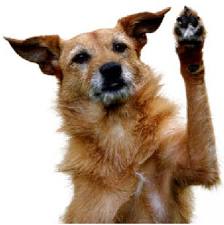Jumping
How do I stop my dog from jumping up at me or other people?
Why do they do it? Dogs often jump in excitement or greeting. They play with each by bouncing around. This can be great fun when playing with your dog, or using play or toys in training. It can also of course be problematic, if the jumping occurs excessively in greeting us, our visitors or even strangers out & about. So how do we get a handle on jumping? First we need to decide on an alternate behaviour that we will reward (highly!) instead.
With all the behaviours, begin practicing with the least distractions. Perhaps when you've already been home some time, or practice near the front door when no visitors are there. Gradually add the distraction level as your dog becomes more proficient. You could gradually increase visitor arrival by adding in a knock/doorbell, then have a visitor arrive but not come in. If your dog can't perform the alternate behaviour, drop down the distraction level for a bit. Initially you won't be waiting for the dog to make a good choice: setup the distraction (starting at the lowest level) & reward them before they've even considered jumping! Over time and repetition your dog will be able to make the good choice to stay on 4 feet. Importantly we want to pre-empt that our dog is going to jump, & deliver our reward BEFORE they jump. We need to pay attention to timing. A dog will repeat a behaviour they perceive is delivering a pleasing result: if we accidently reinforce a cycle of jump-get down-reward, then that could be what we get. The occasional miss is OK, but watch it doesn't become a pattern. Training 4 Paws (4 feet on the ground) To shape '4 paws', you can start by simply tossing a few treats on the ground, right in front of your dog. '4 paws' comes to mean treats delivered in a fun way. Sniffing & chasing treats often increases their value, takes longer for the dog to eat them, and you can use your delivery of the food to help move your dog (away from the door for example). A lead or baby gate can help to manage your dog's access to visitors while they are learning. This can help them succeed by limiting their options. Clear communication of what behaviour is rewarded in a particular environment/context also helps to avoid frustration, both in our dogs & us! Remember that lots of behaviour we see as problematic is 'normal' dog behaviour. Be patient and the time put in for training alternates rewards us handsomely in the end. Reach out to a PPGA trainer for help tailored to your dog & home. |

